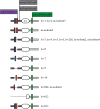Myosin Binding Protein-C Slow Phosphorylation is Altered in Duchenne Dystrophy and Arthrogryposis Myopathy in Fast-Twitch Skeletal Muscles
- PMID: 26287277
- PMCID: PMC4642557
- DOI: 10.1038/srep13235
Myosin Binding Protein-C Slow Phosphorylation is Altered in Duchenne Dystrophy and Arthrogryposis Myopathy in Fast-Twitch Skeletal Muscles
Abstract
Myosin Binding Protein-C slow (sMyBP-C), encoded by MYBPC1, comprises a family of regulatory proteins of skeletal muscles that are phosphorylated by PKA and PKC. MYBPC1 missense mutations are linked to the development of Distal Arthrogryposis-1 (DA-1). Although structure-function details for this myopathy are evolving, function is undoubtedly driven by sequence variations and post-translational modifications in sMyBP-C. Herein, we examined the phosphorylation profile of sMyBP-C in mouse and human fast-twitch skeletal muscles. We used Flexor Digitorum Brevis (FDB) isolated from young (~2-months old) and old (~14-months old) wild type and mdx mice, and human Abductor Hallucis (AH) and gastrocnemious muscles carrying the DA-1 mutations. Our results indicate both constitutive and differential phosphorylation of sMyBP-C in aged and diseased muscles. We report a 7-35% reduction in the phosphorylation levels of select sites in old wild type and young or old mdx FDB mouse muscles, compared to young wild type tissue. Similarly, we observe a 30-70% decrease in the phosphorylation levels of all PKA and PKC phospho-sites in the DA-1 AH, but not gastrocnemius, muscle. Overall, our studies show that the phosphorylation pattern of sMyBP-C is differentially regulated in response to age and disease, suggesting that phosphorylation plays important roles in these processes.
Figures









References
-
- Ackermann M. A., Hu L.-Y. R., Bowman A. L., Bloch R. J. & Kontrogianni-Konstantopoulos A. Obscurin interacts with a novel isoform of MyBP-C slow at the periphery of the sarcomeric M-band and regulates thick filament assembly. Molecular biology of the cell 20, 2963–2978, 10.1091/mbc.E08-12-1251 (2009). - DOI - PMC - PubMed
-
- de Tombe P. P. Myosin binding protein C in the heart. Circ Res 98, 1234–1236, 98/10/1234 (2006). - PubMed
Publication types
MeSH terms
Substances
Grants and funding
LinkOut - more resources
Full Text Sources
Other Literature Sources

